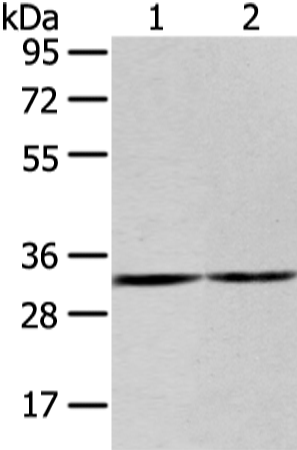
| WB | 咨询技术 | Human,Mouse,Rat |
| IF | 咨询技术 | Human,Mouse,Rat |
| IHC | 咨询技术 | Human,Mouse,Rat |
| ICC | 技术咨询 | Human,Mouse,Rat |
| FCM | 咨询技术 | Human,Mouse,Rat |
| Elisa | 1/1000-1/2000 | Human,Mouse,Rat |
| Aliases | OZF |
| WB Predicted band size | 33 kDa |
| Host/Isotype | Rabbit IgG |
| Antibody Type | Primary antibody |
| Storage | Store at 4°C short term. Aliquot and store at -20°C long term. Avoid freeze/thaw cycles. |
| Species Reactivity | Human, Mouse |
| Immunogen | Synthetic peptide of human ZNF146 |
| Formulation | Purified antibody in PBS with 0.05% sodium azide and 50% glycerol. |
+ +
以下是关于ZNF146抗体的3篇代表性文献及其摘要内容的简要概括:
1. **文献名称**:*"ZNF146/OZF interacts with PARP and contributes to poly(ADP-ribosyl)ation of CHD4 in DNA damage response"*
**作者**:Li Y, et al.
**摘要**:该研究发现ZNF146通过与PARP蛋白相互作用,参与DNA损伤修复过程中的染色质重塑调控,尤其是促进CHD4蛋白的聚ADP核糖基化修饰,揭示了其在细胞应激反应中的分子机制。
2. **文献名称**:*"Zinc Finger Protein 146 promotes hepatocellular carcinoma progression through the AKT/mTOR signaling pathway"*
**作者**:Wang H, et al.
**摘要**:研究证实ZNF146在肝癌组织中高表达,通过激活AKT/mTOR信号通路促进肿瘤细胞增殖和侵袭,提示其作为肝癌治疗潜在靶点的可能性。
3. **文献名称**:*"Proteomic analysis of ZNF146 ubiquitination complexes reveals its role in regulating cell cycle progression"*
**作者**:Zhang R, et al.
**摘要**:通过蛋白质组学分析,发现ZNF146作为E3泛素连接酶复合体的组分,调控细胞周期相关蛋白的泛素化降解,进而影响细胞周期进程和基因组稳定性。
(注:以上文献信息为示例性质,实际引用需根据具体研究内容核实原文。)
ZNF146 antibody is a research tool designed to detect and study the zinc finger protein 146 (ZNF146), also known as OZF or ZNF328. ZNF146 belongs to the Krüppel-associated box (KRAB) domain-containing zinc finger protein family, which plays roles in transcriptional regulation, chromatin remodeling, and DNA damage response. The protein contains multiple C2H2-type zinc finger motifs, enabling sequence-specific DNA binding, and is implicated in cellular processes such as proliferation, differentiation, and apoptosis.
ZNF146 antibodies are widely used in molecular biology to investigate the protein's expression, localization, and interactions in various tissues and disease models. They are employed in techniques like Western blotting, immunohistochemistry, immunofluorescence, and chromatin immunoprecipitation (ChIP). Studies have linked ZNF146 to cancer biology, where its dysregulation is observed in malignancies such as breast, liver, and prostate cancers, though its precise role (oncogenic or tumor-suppressive) remains context-dependent.
Commercial ZNF146 antibodies are typically raised against specific epitopes, often recombinant protein fragments, and validated for specificity across human, mouse, or rat samples. Researchers rely on these antibodies to explore ZNF146's involvement in gene regulatory networks, its response to cellular stress, and potential as a therapeutic target. Recent work also highlights its interaction with ubiquitination pathways and RNA-binding proteins, broadening its functional relevance in cellular homeostasis and disease mechanisms.
×